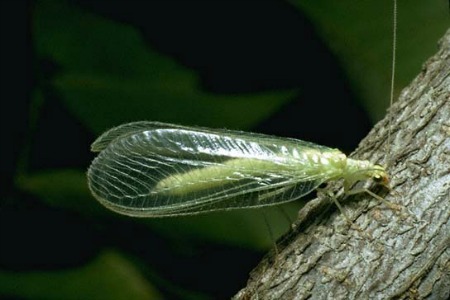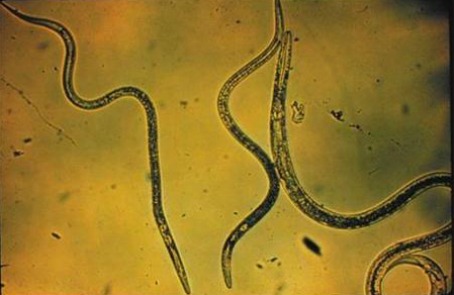A couple of weeks ago we discussed bugs and the damage they can do to your garden. So the logical step is to discuss what you can use to keep these garden killers away.
Oddly enough, some of the remedies are (no kidding) bugs!! That’s right. Just doesn’t seem right does it? But, it is true. Bugs still creep you out?
We will also discuss things you can mix up and put directly on your plants, ingredients that are safe and some you probably have in your home right now.
If you’re just as concerned about pesticides on your food as I am you’re going to love this article.
Good Bugs For Your Garden
- Lady Bugs. Who doesn’t love the cute ladybug? Now you have more reasons to love them. Most lady bugs feed on aphids and other soft bodied insects. Adults will be attracted to your garden if there is pollen and nectar as they need these things to reproduce.

Ladybug
- Lacewings. Lacewings feed on aphids and other types of insect pests. To attract them plant, “composite” flowers, like yarrow, goldenrod, black-eyed Susan and asters.

Lacewing
- Braconids, Chalicids and Ichneumon Wasps. These helpful insects target leaf-eating caterpillars. Attract them by planting carrots, celery, parsley, caraway and Queen Anne’s lace (Umbelliferae family). It’s the flower that attracts these garden savers so let them bloom.

Braconid Wasp
- Praying Mantis. The Praying Mantis is a large insect that loves to munch on bad garden pests. You must order the eggs of the Praying Mantis and place them in your garden, where they will waste no time hatching and doing the job you placed them there to do.

Praying Mantis
- Hover-Flies. Hover-Flies (and their larvae) do pretty much the same job as the, “Lacewing”. They are also attracted by the same flowering plants. Two different bugs sometimes are better than one.

Hover Fly
- Nematodes. Nematodes will go after cutworms, beetles and root weevil larvae. They are harmless to humans and pets. This helpful garden bug comes in a small sponge that has a million of them at a time. Mix with water and apply to the soil where they hatch. If they get on your plants just wash them to the ground with water. They are available at most garden centers and nurseries or you can order them online.

Nematode
- Another great idea is to set aside a small plot for flowering plants that will attract beneficial garden bugs and insects. Flowers to plant: Achillea filipendulina, Alyssum,
Amaranthus, Anethum graveolens (Dill), Angelica gigas, Convolvulus minor, Coreopsis,
Cosmos bipinnatus, Digitalis,Daucus Carota (Queen Anne’s lace), Foeniculum vulgare (Fennel), Helianthus annulus, Iberis umbellata, Limonium latifolium (Statice), Lupin,
Melissa officinalis (Lemon balm), Petroselinum crispum (Parsley), Scabiosa (Pincushion flower), Shasta Daisy, Sunflowers, Tanacetum vulgare (Tansy), Verbascum thaspus, and Yarrow.
Non-Toxic Homemade Remedies
- Soft-bodied insects (mites, aphids, mealybugs):Mix one tablespoon canola oil and a few drops of Ivory dish soap into a quart of water. Shake well and pour into a spray bottle. Spray plant from above down, and from below, getting the underside of the leaves.
- Earwigs, slugs, and other soft-bodied garden pests:I’m for anything that gets rid of Earwigs and Slugs. Sprinkle, “diatomaceous,” over plants and around edges of garden beds. The particles are tiny, yet sharp, but only harmful to the small exoskeletons of insects, slugs and snails. Insects cannot become immune because this is not a chemical pesticide.
- Grubs: For garden grubs, unless you plan to dig them up and use them as fishing bait, there is a natural remedy called, “milky spore”. When you spread the granules on the soil it causes the grubs to contract a disease that kills them. Milky spore multiplies over time and will sit inactive, waiting for grubs to infect. They say one treatment will last 40 years.
- Mites and other insects:You can declare war on these insects by mixing two tablespoons of hot pepper sauce or cayenne pepper with a few drops of Ivory soap into a quart of water. Let stand overnight, then stir and pour into a spray bottle and apply as above. Shake container frequently during application.
Do you have a tip or trick you use to get rid of garden pests?
How do I get rid of aphids in a greenhouse?
How about squash bugs? Squash vine borers?
Nancy,
Neem oil or insecticide soap do a pretty good job.
I am really scared of earwigs and I would be really freaked out if they came into my home or garden. So, I liked that you explained that sprinkling diatomaceous can get rid of them in my garden. If I find any in my home I should probably call a pest control company to handle that for me.
I think it would be nice to get the right kind of information about pests. I think it would be nice to be able to know where the spray needs to go.Thank you for your blog post.
I love these “natural” pest remedies – whoever thought that you could control garden pests with other insects??? I love lady bugs, so I’ll definitely be trying to find ways to keep them around!!
Does the ivory dish soap work for succulents and other desert plants?
Lindsey,
I’d say it’s worth a try, certainly shouldn’t hurt anything.
Generally, it is customary for termite control work to be guaranteed from one to five years. Make sure you know what the guarantee covers and determine if there is a yearly inspection charge.
What an awesome guide on bugs that could rid of pests in a natural way! I never knew that the praying mantis was actually a helpful addition to your garden and I might want them there. How much does it usually cost to get the eggs?
I’ve heard of some farmers actually ordering boxes of lady bugs to release in their fields as a form of natural pest control. I’ll have to try and plant vegetables and flowers for their nectar and pollen, as you mentioned, to try and attract them naturally. That should help to keep aphids at bay.
I have seen success using Cedargard, a cedar oil emulsion I bought from Natural Resources Group (NRG) in California. My blackberries were infested with thrips and were attacked by a number of other insects also. I sprayed about a 1.5% solution of the Cedargard, and waited for the ladybugs to show up. They never came in any quantity, but after about ten days the thrips were disappearing. I also started noticing tiny – about 1/8 inch body size – crab spiders. They increased, and the thrips nearly disappeared. Other insects diminished somewhat also, but not as dramatically as the thrip disappearance. I have also had some success with cedargard on string beans and tomatoes for controlling spider mites. In that case, the predator was (I believe) a tiny black beetle shaped like a ladybug and I think it is a related species. At least I saw a lot more of them.
Stan Moulton
Thank you Stan for this great information on bug/pest control.